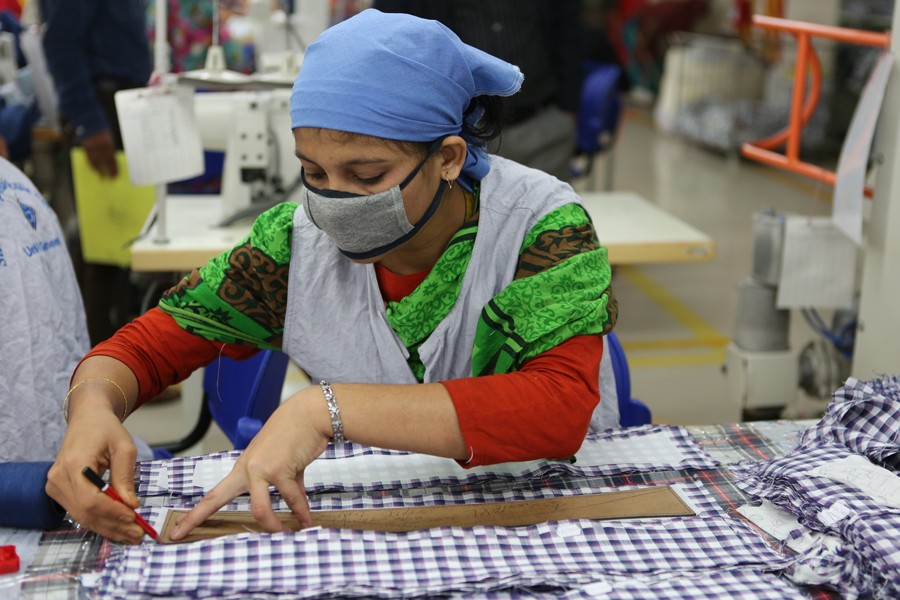
Published :
Updated :

For quite sometime now experts have been putting forward unambiguous suggestions for diversifying the product portfolio of Bangladesh's apparel industry (RMG). Its rival countries such as China and Vietnam have already taken the effort to seriously diversify their baskets of apparel export, whereas Bangladesh still remains indifferent. Even India and Indonesia fall into the category of 'diverse'.While Bangladesh is one notch above Pakistan, that is hardly of any consequence because Bangladesh is number two in global apparel trade, and the time has arrived to start diversifying. The faster it is the better. A glimpse into the US market – very important for Bangladesh RMG – reveals the exporting country's overwhelming reliance on cotton products.
According to a report published in this newspaper recently, government data show "over 80 per cent of Bangladesh's apparel export earnings in the last fiscal year came from shipping basic items like tee shirts, trousers, shirts, sweaters and underwear to the Western market. Local apparel manufacturers acknowledge that diversification does not happen overnight: it requires investment, infrastructure support, consistent energy and raw material supplies and, of course, time." These were findings by Dr. Sheng Lu, who is an Associate Professor and Director of Graduate Studies in the Department of Fashion and Apparel Studies at the University of Delaware, USA. His study tells us that China remains number one exporter primarily because of the wide selection of clothing styles it offers its customers.
Given the geopolitical situation, it is clear that the US policymakers are keen to diversify its sourcing of apparels away from China. Some countries like Vietnam and India are looking forward to taking a share of that pie. In the past, the RMG industry was more than confident that it would be able to grab a large percentage of that pie, now it is hamstrung with its concentrated outlook on its product base. Hence, Vietnam is stepping into this game better equipped than Bangladesh as it can offer a wider selection of products to choose from (from a buyers' perspective) that include outerwear, under garments and swimwear. India is doing well in dresses whereas Bangladesh is still a major buyer destination for basic knitwear items. Basic, i.e. Bangladesh is very good at producing items that also carry a lower price tag.
One of the areas that the apparel industry association, the BGMEA has been looking into is value-added products, particularly non-cotton materials that include polyester and manmade fibres (MMF). This is an effort to shift away from cotton and for obvious reasons. For Bangladesh to attain the target of US$100 billion in export earnings by 2030, something fundamental needs to change in the industry. A move away from over-dependence on cotton-based apparels to the MMF!
In a recently unveiled BGMEA study titled 'Beyond Cotton: A Strategic Blueprint for Fibre Diversification in Bangladesh Apparel Industry', the potential of Fibre diversification of non-cotton textile and apparel for Bangladesh in the global apparel market has been explored. Global trade (cotton and non-cotton) has increased marginally from 1.0 per cent from 2018 to 2022. Indeed, wool fibre, yarn, and fabric trade have declined notably over the last five years, while over the same period, acrylic fabric exports have increased since 2018.The study reveals that non-cotton apparel exports by China, Vietnam, Italy and Spain have dominated that particular garment export scene where it accounts for more than 50 per cent of total exports. "The fastest-growing non-cotton categories globally, Jerseys and Pullovers of Man-Made Fibres (MMF) lead the way, and women's wear categories (outerwear, dresses, and trousers dominate the list."
So, what will Bangladesh do? It holds 2nd position in production and is squarely aligned with current market demands of international markets. To be able to catch up and compete with its closest rivals in the MMF and non-cotton segments, some problems remain. There is the challenge of a shortage of technical manpower, the overall reliance on imported raw materials, high manufacturing cost, and significant capital expenditure requirements.
What the industry is looking for is greater understanding of the problems facing it at policy level. The capital-intensive nature of investments requires a rethinking of high interest rates charged by financial institutions and more non-cotton-focused government policies. There is a huge demand for vocational training institutes that would go a long way to address the technical competences of Bangladeshi workers and of course, the availability of consistent power supply. Diversification won't happen magically, it requires an enabling environment whereby decision makers work with the industry to find solutions rather than simply adopting a top-down approach. These are serious issues and as RMG remains the top foreign exchange earner in annual exports, these issues need to be tackled head on if Bangladesh is to remain a dominant player in the global apparel trade.
mansur.thefinancialexpress@gmail.com


 For all latest news, follow The Financial Express Google News channel.
For all latest news, follow The Financial Express Google News channel.